sábado, 10 de diciembre de 2016
domingo, 3 de julio de 2016
A TRIBUTE TO ELVIS
- Jeffrey Schrembs, Elvis Presley historian, expert and collector (as published in www. ElvisCollector.info on March 26, 2009)
Having watched Elvis onstage during his entire career, I was always amazed how Elvis was able to adapt to his audience and always rise to the occasion. Elvis was the most exciting stage performed who ever sat foot on a stage. He never allowed his music to be "manipulated" and his "light show" consisted of a handful of color lights masterfully choreographed by Lamar Fike. He had the vocal mastery to take a contemporary iconic song such as "Bridge Over Troubled Water"´ ( starting in 1970), and make it is his own. As of 1971, for instance, he would pour out his heart out onstage and could go from the buildup of "2001 A Space Odyssey" to "Johnny B Goode", to the gospel song "How Great Thou Art" and, before the audience could recover from the emotional experience of hearing/seeing Elvis perform these songs with vocal excellence, he would turn to singing one of his hits such as "Suspicious Minds". He surrounded himself with the best of the best, pertaining to the orchestra to the band, to the backup singers etc., and everyone who worked with him has confirmed that Elvis' vocal range has never been equalled. Even when Elvis' health problems were the most dramatic (i.e. visually, physically, mentally, emotionally, etc.), he sang his heart out and if you listen to the "CBS 1977 Concert", which aired after Elvis died sadly, Elvis' talent and vocal range is almost a "spiritual experience", touching something wonderful inside of our soul and leaving its imprint for all time. Hence, our ears after hearing the exceptional talent of Elvis' voice long for the time when Elvis sang live and/or put out a new album, and hearing him sing was a true blessing. (In fact), not a day goes by that I don't' miss Elvis Presley as a performer - as a Father to his daughter - and as a charitable man - and as a beloved friend surrounded by lifetime friends (i.e. Marty Lacker, Red West, Sonny West, Lamar Fike, Billy Smith, etc.), leaving us three decades of exceptional music. Elvis Presley took the talents that God gave him and shared them with the world, gave us his time and did so with grace. These are lessons that all of us can learn from and celebrate from generation to generation.
miércoles, 22 de junio de 2016
Elvis’s Pet Names For Special Women in His Life
Elvis's Pet Names
For Special Women in His Life
Elvis and his guys had some kind of pet name for each other and for almost anybody else who spent some time around him. Below are nicknames given to 10 women in Elvis's life. They range from relatives to girlfriends to movie costars. First, check out the list below and see how many you can identify. Then read on to see how you did.
"Satnin" / "Little" / "Dodger" / "Foghorn" / "Nungen" / "Ooshie" / "Thumper" / "Mommy" / "Gingerbread" / "Josephine"
Unless otherwise stated, most of the following information comes from either the 1992 book, Elvis: From Memphis to Hollywood by Alan Fortas, or the 1995 volume, Elvis Aaron Presley: Revelations from the Memphis Mafia, by Billy Smith, Marty Lacker, and Lamar Fike.
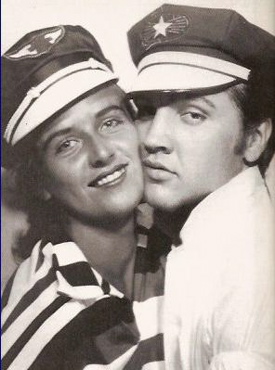 "Satnin": Gladys Presley, June Juanico, Priscilla Presley
"Satnin": Gladys Presley, June Juanico, Priscilla Presley Elvis liked this nickname so much that he used it for three women in his life. His mother was the first. Then there was June Juanico (right), a 1956 girlfriend from Biloxi, Mississippi. Finally, he used "Satnin" as a pet name for Priscilla.
The origin of the term "Satnin" is in dispute. Elvis's cousin, Billy Smith, claims, "Satnin' meant a real condensed round of fattening, and Aunt Gladys was always heavy. Elvis would pat her on the stomach and say, 'Baby's going to bring you something to eat, Satnin'."
However, in her 1997 book, Elvis: In the Twilight of Memory, June Juanico said "Satnin" had a different origin. It was while on a date in Memphis in May 1956 that Elvis first called June, "My beautiful little Satnin." When she asked where the term came from, he explained: "She (his mother) used to sing to me when I was little. You remember the song, 'Mammy's Little Baby Loves Shortnin' Bread'? Well, she used to sing 'mama's little baby has satnin skin.' You know, June, skin soft as satin."
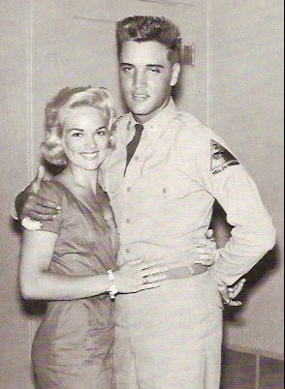 "Little": Anita Wood
"Little": Anita Wood
 "Little": Anita Wood
"Little": Anita WoodGeorge Klein introduced 19-year-old Anita to Elvis in 1957, and she remained his preferred girlfriend until his induction into the army a year later. She remembers the last thing Elvis said to her before he went overseas: "I love you, Little …" Even after Elvis met Priscilla in Germany, he continued to call Anita and send her presents. She was still in the picture when Elvis returned from the army, and it wasn't until 1962, when she found out about Elvis and Priscilla, that she ended her relationship with Elvis.
Years later she saw his show in Las Vegas and met him backstage. She says Elvis told her, "Little, I wondered if we made a mistake." She responded, "No Elvis, we didn't, you wouldn't have Lisa and I wouldn't have my children and my husband." She never saw Elvis again after that night.
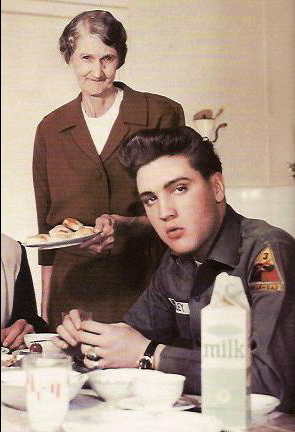 "Dodger":
"Dodger":Minnie Mae Presley
Minnie Mae Presley was Elvis's grandmother and the mother of Vernon Presley. Her husband Jessie deserted her in 1942, and after Elvis became wealthy, he gave her a home for the rest of his life. She even lived with Elvis during his army stint in Germany. Minnie Mae outlived her famous grandson, dying on May 8, 1980.
Lamar Fike described Minnie Mae as a, "tough old bird. Tall, skinny, and peppery. Elvis called her 'Dodger' because he threw a ball once and it missed her face by a fraction of an inch."
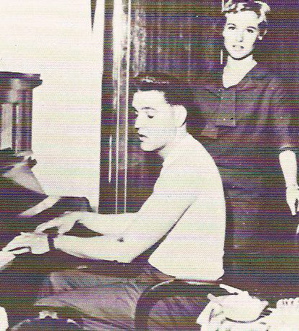 "Foghorn":
"Foghorn":
Elisabeth Stefaniak
 "Foghorn":
"Foghorn":Elisabeth Stefaniak
Elisabeth was German-born but as a teenager became an American citizen through her stepfather, a American soldier. She was 19 in 1958 when she met Elvis at the base movie theater in Germany. After they dated a few times, Elvis convinced her parents to let Elisabeth move in with him as his personal secretary. She answered Elvis's fan mail for the remainder of his time in Germany. Privately, the two continued their personal relationship.
When he left Germany and the army in March 1960, Elvis took Elisabeth back to Memphis with him to continue as his personal secretary. In Elvis the Soldier, which she co-wrote, Elisabeth recalls that one day at Graceland, Elvis told her, "Foghorn (a nickname he had always called me because of my low voice), I'm going to take you for a motorcycle ride." Soon afterwards Elisabeth left Graceland to marry Rex Mansfield, Elvis's closest friend during his army hitch.
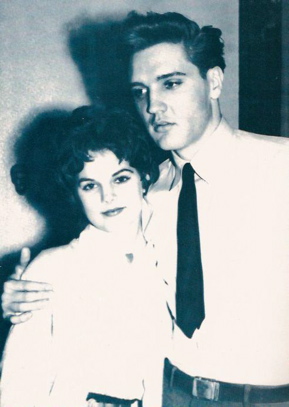 "Nungen": Priscilla Presley
"Nungen": Priscilla Presley "They'd baby-talk back and forth," recalls Lamar Fike of Elvis and Priscilla. "He called her 'Nungen,' which was Elvis for 'young one.' But he also started calling her 'Satnin' since Gladys was gone."
Alan Fortas remembers that "Fire Eyes" was one of Priscilla's pet names for Elvis. "Elvis, with his history of baby talk, already had four hard-to-take nicknames for Priscilla," Fortas added. "'Nungen,' which was an affectionate twist on 'young one,' 'Cilla,' 'Little One,' and the one he began using with increased frequency, now that its former owner didn't need it anymore: 'Satnin.'"
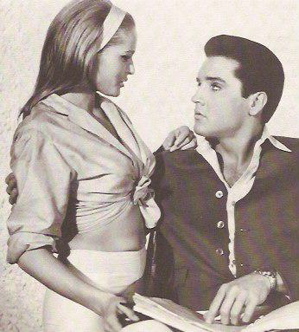 "Ooshie": Ursula Andress
"Ooshie": Ursula Andress
 "Ooshie": Ursula Andress
"Ooshie": Ursula AndressMarty Lacker remembers seeing a picture of Elvis and Ursula gazing into each other's eyes on the set of Fun in Acapulco. "Like they're ready to gobble each other up. But that wasn't any real big romance. He just enjoyed being with her. She came to visit him on the Roustabout set later on. Her nickname was 'Ooshie'."
Alan Fortas said the guys had a lot of fun when Ursula was around, but Elvis wasn't interested in her romantically because she was married to John Derek at the time. Still, Elvis and Ursula flirted with each other, according to Billy Smith, and she would call Graceland occasionally. "She wouldn't ask for Elvis," Billy says, "because she knew Priscilla was there. So she'd ask for Alan … and Alan would call her back, and Elvis would get on the phone."
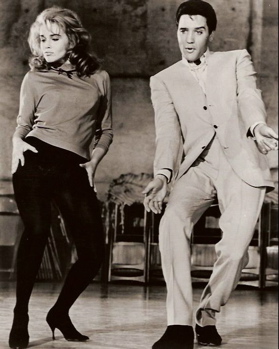 "Thumper": Ann-Margret
"Thumper": Ann-Margret "I believe Ann-Margret really did care a lot for Elvis," said Alan Fortas in his book. "And I think she truly wanted to marry him, even though she knew full well about Priscilla, and used the code names 'Scoobie' and 'Bunny' when she telephoned him at Graceland. (The guys joked that 'Thumper' would be more appropriate.)"
Marty Lacker remembers another nickname the guys had for her. "Ann genuinely liked people, and she liked every one of us. I think she also respected us. We used to have a lot of fun with her. She had a terrific sense of humor. We called her 'Rusty' because that was her name in the movie and because of her red hair."
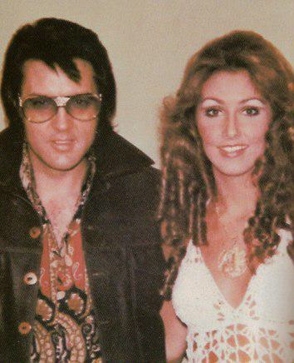 "Mommy":
"Mommy":
Linda Thompson
 "Mommy":
"Mommy":Linda Thompson
In the summer of 1972, George Klein introduced 22-year-old Linda Thompson to Elvis at the Memphian theater. She soon became his live-in girlfriend and primary caregiver for the next four years. Eventually, Elvis's bizarre behavior became too much for Linda to handle, and she finally left Elvis in November 1976.
"Linda was the best woman he had ever been with," judged Marty Lacker. "He called her 'Mommy,' and she called him 'Little Baby Buntin'.' She cared about him. She wouldn't fall asleep at night until after Elvis did. If something happened while he was sleeping, she'd be up in a minute."
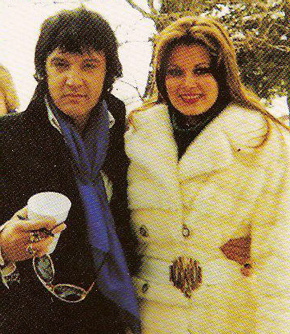 "Gingerbread":
"Gingerbread":Ginger Alden
George Klein, Elvis's main girlfriend-finder through the years, introduced 19-year-old Ginger Alden to Elvis at Graceland in November 1976, shortly before Linda Thompson's relationship with Elvis ended. "I don't know that there was any way that relationship could work," noted Marty Lacker. "Ginger wanted to go out and party all the time and show Elvis off. And she wanted him to socialize with her group of friends—all sorts of things that Elvis wouldn't do."
Elvis's pet name for his last girlfriend was "Gingerbread." Billy Smith's alternate nickname for her, however, reflected how much the guys disliked her. "Elvis didn't know it," says Billy, "but I always called her 'Gingersnatch.' And I didn't stop there. I called her sister Rosemary 'Poundcake.' Which was really crude of me, but I couldn't help it. I was so pissed off at that family."
"Josephine": Jo Smith
Billy Smith's wife Jo deeply resented Elvis for taking her husband away from her and their children for long periods of time to make movies. Still, toward the end of Elvis's life, she moved into a trailer with Billy on the Graceland grounds because she knew how close the two cousins were to each other.
"After we'd been back with him a little while, my feelings about Elvis changed," she recalls. "He called me Josephine. That's not my name. But every single time he came down the steps, he sang that Fats Domino song to me, 'Hello, Josephine.' And he'd give me a big bear hug. He told me, "I'm going to make up for all the pain I put you through."
"Record 100,000 Pay Ecstatic Tribute To Presley In Triumphant Florida Tour"
"Record 100,000 Pay Ecstatic Tribute
To Presley In Triumphant Florida Tour"
The above headline appeared on the front page of the Tampa Sunday Tribune on August 12, 1956. The day before Elvis Presley had completed a 9-day, 7-city, 25-show barnstorming tour of Florida, from Miami in the south to Jacksonville in the north. It was the most intense and exhausting tour during Elvis's breakout year. In his article, Tribune writer Paul Wilder tried to put the wild Presley tour of Florida into perspective.
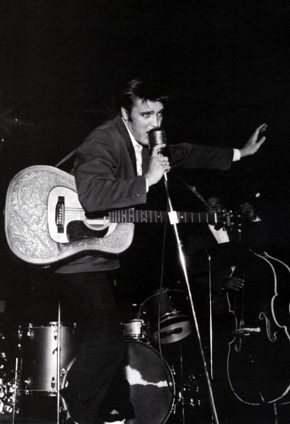 When Elvis arrived in Florida, he was coming off a month's vacation from his hectic 1956 touring schedule. He spent most of July relaxing in Memphis and visiting girlfriend June Juanico in Biloxi, Mississippi. Following his July 1 appearance on the Steve Allen Show, Elvis was not due back on TV until the Sullivan show in the fall. Things were relatively quiet for Presley on the record charts, as well. Having finished its run at #1, "Heartbreak Hotel" was slowly sliding down the "Top 100." His second 1956 single, "I Want You, I Need You, I Love You," had reached the top 10, but stalled at #3.
When Elvis arrived in Florida, he was coming off a month's vacation from his hectic 1956 touring schedule. He spent most of July relaxing in Memphis and visiting girlfriend June Juanico in Biloxi, Mississippi. Following his July 1 appearance on the Steve Allen Show, Elvis was not due back on TV until the Sullivan show in the fall. Things were relatively quiet for Presley on the record charts, as well. Having finished its run at #1, "Heartbreak Hotel" was slowly sliding down the "Top 100." His second 1956 single, "I Want You, I Need You, I Love You," had reached the top 10, but stalled at #3.
 When Elvis arrived in Florida, he was coming off a month's vacation from his hectic 1956 touring schedule. He spent most of July relaxing in Memphis and visiting girlfriend June Juanico in Biloxi, Mississippi. Following his July 1 appearance on the Steve Allen Show, Elvis was not due back on TV until the Sullivan show in the fall. Things were relatively quiet for Presley on the record charts, as well. Having finished its run at #1, "Heartbreak Hotel" was slowly sliding down the "Top 100." His second 1956 single, "I Want You, I Need You, I Love You," had reached the top 10, but stalled at #3.
When Elvis arrived in Florida, he was coming off a month's vacation from his hectic 1956 touring schedule. He spent most of July relaxing in Memphis and visiting girlfriend June Juanico in Biloxi, Mississippi. Following his July 1 appearance on the Steve Allen Show, Elvis was not due back on TV until the Sullivan show in the fall. Things were relatively quiet for Presley on the record charts, as well. Having finished its run at #1, "Heartbreak Hotel" was slowly sliding down the "Top 100." His second 1956 single, "I Want You, I Need You, I Love You," had reached the top 10, but stalled at #3. But August ushered in another round of Presleymania. The new single, "Hound Dog" and "Don't Be Cruel," exploded onto the Billboard charts, and Elvis took his raucous road show into Florida.
After 7 shows at Miami's Olympia Theatre on August 3-4, Elvis headed northwest, zigzagging across the state like an out-of-control twister. Two shows at the Armory in Tampa on the 5th were followed by 3 shows at Lakeland's Polk Theatre on the 6th and three more at the Florida Theatre in St. Petersburg on the 7th. The next day he played 2 shows at Orlando's Municipal Auditorium. Then it was back again to the east coast for 2 shows at the Peabody Auditorium in Daytona Beach. The Florida tour ended in Jacksonville with 6 shows on August 10-11.
Wilder detailed the trail of excitement and controversy that followed Presley's path through the state that week. "No matter what radio station you turned to, you would hear Presley's off-beat voice wailing some sloppy gush like Heartbreak Hotel or Don't Be Cruel," the writer noted. "No matter what newspaper you looked in you would find reports of near-riotous conditions prevailing when he was appearing in that town." TV Guide had an interview scheduled with Elvis in Tampa, but things got so wild there that it had to be put off until the next day in Lakeland. Even then, Presley could only give the magazine a half hour of his time.
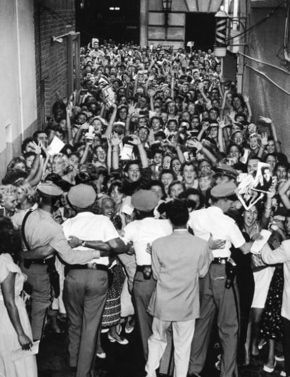 In homes and on the streets, Elvis became the state's main topic of conversation that week. "There is nothing in Florida entertainment history to compare him with," declared Wilder, "and the startling impact of Presley's sway over Florida's teen-agers—and many adults, too—is something unique in the state's social, economic, and entertainment life."
In homes and on the streets, Elvis became the state's main topic of conversation that week. "There is nothing in Florida entertainment history to compare him with," declared Wilder, "and the startling impact of Presley's sway over Florida's teen-agers—and many adults, too—is something unique in the state's social, economic, and entertainment life." Wilder provided a Presley "box score" as his initial step in measuring Elvis's influence on Florida. He listed total attendance in each city: Miami … 14,000; Tampa … 10,000; St. Petersburg … 6,500; Lakeland … 5,500; Orlando … 7,000; Daytona Beach … 5,000; Jacksonville … 15,000. That added up to 63,000 "screaming, howling people" who saw Presley perform in Florida's theatres and auditoriums. To that total Wilder added a few thousand more who crowded around to see him outside the venues and others who got glimpses of him in local restaurants and riding around city streets in his white Lincoln Continental. "You might say that Presley was seen in person by 100,000 persons in Florida in the last week," Wilder concluded, "a record approached by no other entertainer in Florida's history."
And how much cash did Presley make in Florida that week? Wilder couldn't get Colonel Parker to tell him the amount, so he calculated the ticket take on his own. Conservatively taking the lowest ticket price for Presley's Florida shows ($1.50) and multiplying by the estimated number of admissions, Wilder came up with a Florida appearance tour gross conservatively at $100,000 for Elvis. "Ever hear of anyone else making $100,000 a week in Florida, in the entertainment or any other business," Wilder asked his readers.
• Fans kept away but Elvis still mobbed by professionals
Excitement and controversy flared up wherever Presley appeared in Florida. In Tampa, while security forces kept teenagers away from Elvis, he was mobbed backstage by reporters, photographers, DJs, and friends-of-friends as they fought to get a word from him or a photo taken.
In Jacksonville, a juvenile court judge, who threatened Elvis with arrest if he didn't tone down his act, attended Presley's show to make sure his warning was heeded. Elvis and Colonel Parker both denied that the stage show was changed in any way. According to Wilder, "Presley was willing to face arrest and decide once-and-for-all whether his performances were vulgar or obscene." Elvis made it through his 6 Jacksonville shows without being arrested.
Presley faced another threat in Jacksonville. Al Fast, representing the American Guild of Variety Artists, came to town to issue Elvis an ultimatum—either join the Guild or the union would pull the band from the show. Fast's demand could have backfired. Wilder explained, "If the Guild got in a knock-down-drag-out fight with America's teen-agers, who are Presley's main support, the teen-agers could pull a strike on the union—quit going to hear any of the union bands."
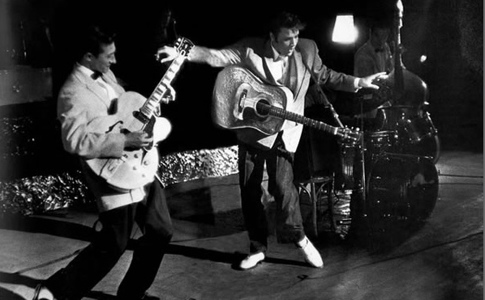
The show Wilder saw in Tampa was reprised in all the other Florida venues. "While on-stage, Presley was the utmost in action," the writer observed. "His dynamic, forceful movements, including jumping, running, bending, twisting, foot-jerking, leg-jerking, hip-jerking, head-jerking, arm-waving and in one act his whole body went into motion in series of sustained shivers that even had his hair flipping back and forth. When he got through singing over one microphone he dashed to another and sometimes threw the mike stands down on the floor when he was through."
There was, however, one stage incident unique to the Tampa show that Wilder saw. "Once he let-go a microphone suddenly and it rocked—then bounced back and hit him on the head—without visible slow-down effect."
The frenzied pace of the Florida tour took a toll on Presley. Wilder saw it between shows. "Backstage, he is completely different. He appears exhausted, listless, colorless, washed out. Yet even as almost a caricature of a beat-up Dead-End Kid—the girls still scream at his sight, moon and worry over his condition." A reporter in Lakeland thought Elvis was about to die. "I feel terrible," he heard Presley moan, as he grabbed his forehead with both hands and swayed back and forth.
• Presley played it up with his Florida female fans
During his Florida press conferences, Elvis used "sir" and "ma'm" when addressing older interviewers, but often teased young females who asked him questions. "Every woman interviewer of near his same age was trembling when in his presence," Wilder noticed, "but he rewarded them with gentle pats on the shoulders, or hugs, or occasionally a kiss—to give them a thrill, and something to write about."
One young woman asked Elvis if he were looking for an ideal girl. "Yes, and I found her," responded Elvis. "Who?" returned the breathless girl. "You," he answered. "She nearly dropped her microphone," Wilder reported.
Elvis's 9 p.m. show on August 11 in Jacksonville closed out his frenetic 1956 swing through Florida. Amazingly, though, the tour was not over. Elvis still had afternoon and evening shows in New Orleans the next day. After that, he took an extended break from touring, making only one public appearance over the following two months. He didn't have much time to relax, though. On August 16, Elvis flew to Hollywood to make his first movie.
_
.
__,_._,___
Blue Moon: Elvis Presley’s Most Unlikely Song
Blue Moon:
Elvis Presley's Most Unlikely Song
I experienced an epiphany concerning this unusual Presley song. It happened in 1990, when my wife and I were watching the Tom Hanks/Meg Ryan film, Joe Versus the Volcano, at a local theater. I was amazed when Elvis's recording of Blue Moon was used in the soundtrack. My whole attitude toward the song changed that night. Part of it was psychological. If some producer thought the recording was worthy enough to use in a major Hollywood movie, then it must be better than I thought. And I had to admit that the song sounded much better in the theater that evening than it ever had on my record player. It still isn't my favorite Elvis song, but I now enjoy listening to it and have come to appreciate Elvis's interpretation of it. 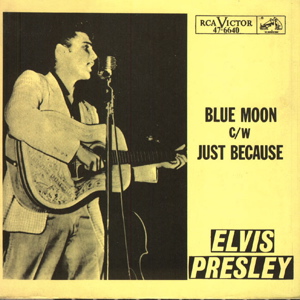

• It's hardly a rockabilly tune
The Rodgers and Hart number was certainly an unlikely song for Elvis to record back in his Sun Records days. While he was crafting his rockabilly style in 1954-1955 with songs like That's All Right, Blue Moon of Kentucky, Good Rockin' Tonight, and Milkcow Blues Boogie, how did something like Blue Moon get into that mix? The Broadway song-writing team of Richard Rodgers and Lorenz Hart originally composed the song while under contract with Metro-Goldwyn-Mayer in 1933. Over a two-year period, Hart wrote three different sets of lyrics for MGM, but the song never clicked in any of the three films for which it was intended.
Finally, in 1934 Rodgers, who always liked the melody, prevailed upon Hart to write a fourth, more romantic, set of lyrics so the song could be released commercially. That's when Hart changed the title to Blue Moon and came up with the familiar lyrics that have been recorded numerous times over the past 75 years. Those who recorded it over the years include Louis Armstrong, Sam Cooke, Billie Holiday, Bob Dylan, Dean Martin, Frank Sinatra, Bobby Vinton, Rod Stewart and Eric Clapton. Before Elvis's, only Mel Torme's version of Blue Moon made one of Billboard magazine's charts, reaching #20 on the "Best Seller" list in April 1949.
As a teenager in Memphis, Elvis probably heard multiple recordings of the song on the radio. He obviously liked the pop ballad, as, according to biographer Peter Guralnick, Elvis was already singing the song when he first hooked up with Sun Records in 1954. In fact, Guralnick believes that Elvis, Scotty Moore, and Bill Black tried to record it in July 1954 as a possible flip slide to That's All Right.
• Elvis's recording an "eerie, clippity-clop version"
However, the first and only verified recording session for Blue Moon took place at Sun Studio on Wednesday night, August 19, 1954. The only musicians at the session were Scotty and Elvis on guitar and Bill on bass. Sam Phillips was in the control booth. Guralnick describes the session and its results as follows:
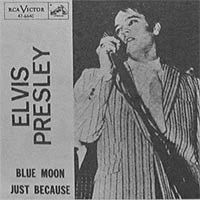 "On August 19 they spent hours doing take after take of 'Blue Moon,' in an eerie, clippity-clop version that resembled a cross between Slim Whitman's 'Indian Love Call' and some of the falsetto flights of the r&b 'bird' groups (the Orioles, the Ravens, the Larks). After it was all over, Sam wasn't satisfied that they had anything worth releasing, but he never uttered a word of demurral for fear of discouraging the unfettered freshness and enthusiasm of the singer."
"On August 19 they spent hours doing take after take of 'Blue Moon,' in an eerie, clippity-clop version that resembled a cross between Slim Whitman's 'Indian Love Call' and some of the falsetto flights of the r&b 'bird' groups (the Orioles, the Ravens, the Larks). After it was all over, Sam wasn't satisfied that they had anything worth releasing, but he never uttered a word of demurral for fear of discouraging the unfettered freshness and enthusiasm of the singer."
 "On August 19 they spent hours doing take after take of 'Blue Moon,' in an eerie, clippity-clop version that resembled a cross between Slim Whitman's 'Indian Love Call' and some of the falsetto flights of the r&b 'bird' groups (the Orioles, the Ravens, the Larks). After it was all over, Sam wasn't satisfied that they had anything worth releasing, but he never uttered a word of demurral for fear of discouraging the unfettered freshness and enthusiasm of the singer."
"On August 19 they spent hours doing take after take of 'Blue Moon,' in an eerie, clippity-clop version that resembled a cross between Slim Whitman's 'Indian Love Call' and some of the falsetto flights of the r&b 'bird' groups (the Orioles, the Ravens, the Larks). After it was all over, Sam wasn't satisfied that they had anything worth releasing, but he never uttered a word of demurral for fear of discouraging the unfettered freshness and enthusiasm of the singer."Take 4 that evening, the one that RCA would eventually release two years later, reveals Elvis's unusual interpretation of the song. Music historian Colin Escott describes it thus: "Elvis skips the bridge and the final verse that contains the happy ending, neatly transforming the 32-bar pop classic into an eerie 16-bar blues." Hart's original lyrics describe a man whose longing for love is finally rewarded. Elvis used only the following two opening stanzas, repeating and separating them with falsetto moans (that's how I categorize the sound now):
Blue moon
You saw me standing alone
Without a dream in my heart
Without a love of my own
You saw me standing alone
Without a dream in my heart
Without a love of my own
Blue moon
You knew just what I was there for
You heard me saying a prayer for
Someone I really did care for
You knew just what I was there for
You heard me saying a prayer for
Someone I really did care for
Elvis left out the following bridge and final verse:
And then there suddenly appeared before me
The only one my arms will ever hold
I heard somebody whisper, "Please adore me"
And when I looked, the moon had turned to gold
The only one my arms will ever hold
I heard somebody whisper, "Please adore me"
And when I looked, the moon had turned to gold
Blue moon
Now I'm no longer alone
Without a dream in my heart
Without a love of my own
Now I'm no longer alone
Without a dream in my heart
Without a love of my own
Certainly, the extremely slow tempo and melancholy delivery of lyrics would not have worked with the happy outcome described by the bridge and final verse.
• Discarded Sun tune released by RCA
Elvis's version was never released on Sun Records. It was among the unused Presley recordings turned over to RCA when it purchased Elvis's contract in late 1955. It was released, along with three other discarded Sun cuts, on Presley's first RCA album in March 1956. In September that year, RCA released Blue Moon as a single backed with another Sun recording, Just Because, as part of a mass singles release. In listing all the titles in its "Review Spotlight" column on September 8, 1956, Billboard labeled them, "Fourteen tunes, formerly available on Presley's LP's or EP's, now available on seven singles, within reach of any kid with 89 cents."
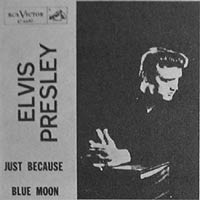 It soon became apparent that of the seven singles, Blue Moon/Just Because was selling the best. In its September 22 issue, Billboard listed that single in both its "Coming Up Strong" and "This Week's Best Buys" lists. "This disk, with emphasis on 'Blue Moon,' is stepping out and starting to move," Billboard reported.
It soon became apparent that of the seven singles, Blue Moon/Just Because was selling the best. In its September 22 issue, Billboard listed that single in both its "Coming Up Strong" and "This Week's Best Buys" lists. "This disk, with emphasis on 'Blue Moon,' is stepping out and starting to move," Billboard reported. Elvis's version of the song entered Billboard's "Top 100" chart at #87 on September 29, 1956. It's chart performance ranks as the most unusual among all of Presley's chart records during his career. While it had a very respectable 17-week run on the "Top 100," it didn't follow the normal chart pattern of steadily rising to a peak and then falling steadily back down the chart.
Instead Elvis's recording went on a chart roller coaster ride. It rose to #55 in its third week, and then fell back to #84 two weeks later. Then it rose back into the '60s for two weeks before falling back into the '90s, where it stayed for 6 weeks. Then it went back up again to #60; then back down to #97 for a couple of weeks. Twice during its up-and-down chart movement the song fell off the "Top 100" completely, only to resurface one or two weeks later. Finally, on February 9, 1957, it exited the chart for good.
• Elvis's first rock 'n' roll version of the song
During its 17 weeks on the "Top 100," Elvis's version of Blue Moon never reached higher than #55. Still it was on the chart longer than I Was the One and Blue Suede Shoes, both of which were top 25 hits for Elvis that year.
Elvis's rendition of Blue Moon is considered that song's first crossover into the rock 'n' roll genre. The song's biggest splash in rock history, however, came in April 1961, when the Marcels' doowop version sold a million copies and knocked Elvis's Surrender off the #1 spot on Billboard's "Hot 100."
A few years later, Elvis had one more obscure connection with the tune. In his 1964 film Viva Las Vegas, while Elvis checks out the chorus girls at the Tropicana Hotel, about 10 seconds of an instrumental version of Blue Moon plays in the background.
And say, what is a "blue moon," anyway? It must have some significance, since Elvis recorded three songs with that term in the title. (Blue Moon of Kentucky and When My Blue Moon Turns to Gold Again are the other two.) Well, technically "blue moon" is the term for a second full moon in a single calendar month. ("Once in a blue moon," then, usually means once a year.) So a "blue moon" really isn't blue, unless, of course, you're the unrequited lover voicing the Richard Rodgers lyrics of the song. Then every moon might seem a little "blue."
Alan Hanson
__._,_.___
.
__,_._,___
Elvis Presley’s four major single record releases in 1956
Elvis Presley's Music in the Fifties
Puzzled Variety's Reviewers
As a weekly entertainment trade magazine, Variety has been published continually since its founding in 1905. Although primarily known for its coverage of motion pictures, the tabloid also reports on many other areas of the entertainment industry. When Elvis Presley exploded on the scene in 1956, Variety's weekly issues contained a section devoted to recorded music. Included were updated charts and reviews of recently released records. Starting with "Heartbreak Hotel" in 1956, Variety reviewed most RCA Presley single releases through 1971, when the magazine scaled back its coverage of recorded music.
Below are Variety's brief reviews of Elvis Presley's four major single record releases in 1956. In reading them, it is important to keep in mind that the journal's subscribers were record sellers. The reviews were intended to help retailers decide which records to stock in their stores. Also, since a good portion of the magazine's advertising space was purchased by record companies, Variety's reviewers were mindful to minimize negative comments in their record reviews, lest RCA and other labels take their advertising dollars elsewhere.
Below, in bold face, are Variety's brief reviews of Elvis Presley's four major single record releases in 1956.
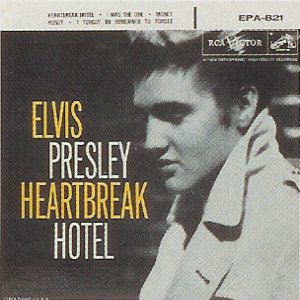 Variety, February 1, 1956:
Variety, February 1, 1956: Elvis Presley: "Heartbreak Hotel"-"I Was the One" (RCA Victor). Elvis Presley, country singer, is a compelling stylist who tears his tunes to tatters a la Johnnie Ray. "Heartbreak Hotel" is an ideal piece of material and he goes to town with the help of an excellent background. It could establish Presley in the pop picture. "I Was the One" is a slow rhythm ballad, also with a good idea and potently rendered.
This review of Elvis's first RCA single appeared in Variety's weekly "Best Bets" list of recommended single record releases. It was fourth down on the list that week behind new releases by Don Rondo, Chuck Berry, and Jo Stafford. As the review notes, at that time Presley was seen as a country singer trying to make the transition into the more lucrative pop music field.
Over a month later, on March 7, Variety reported that, "'I Was the One' is now around the 300,000 sales mark after three weeks on the market." It was apparently unclear to the magazine at that time that "Heartbreak Hotel" was really the hit side. In fact, it would be two more months before that Presley recording would reach the top of the singles chart on May 2, 1956.
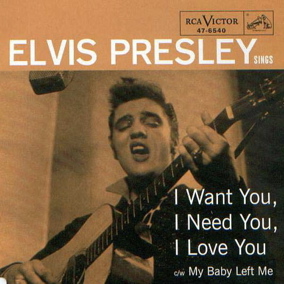 Variety, May 9, 1956
Variety, May 9, 1956
 Variety, May 9, 1956
Variety, May 9, 1956Elvis Presley: "I Want You, I Need You, I Love You"-"My Baby left Me" (RCA Victor). The current phenom of the music biz, Elvis Presley probably could have a hit if his name were on a blank disk. This coupling is sure of a big ride even though the material is not up to the level of his "Heartbreak Hotel" smash. "I Want You" is a slow ballad with a strong beat and Presley belts it with his identifying vocalisthenics. Flip, in a traditional blues vein, also gets an energetic workout.
This review of Elvis's second RCA single appeared in Variety's "Jocks, Jukes and Disks" column. Reviewer Herm Schoenfeld's "blank disk" comment revealed his bewilderment with Presley's sudden popularity. However, his use of the term "vocalisthenics" to describe Elvis's style was insightful, as it linked the singer's recorded voice to his notorious stage gyrations, a combination that had much to do with Presley's early success. Schoenfeld correctly predicted that "I Want You, I Need You, I Love You" was not "up to the level" of "Heartbreak Hotel." Still, it was a hit, reaching #3 on the Billboard singles chart.
Presley's first full page Variety ad appeared in the journal on July 4. It included the following message: "Thanks a million to everybody everywhere! You've been wonderful." Readers were encouraged to write to the "Elvis Presley National Fan Club Headquarters" at "Col. Thomas A. Parker's" office in Madison, Tennessee.
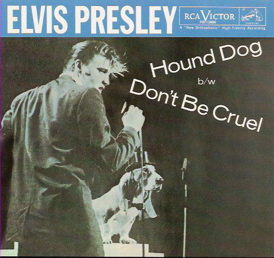 Variety, July 15, 1956:
Variety, July 15, 1956: Elvis Presley: "Hound Dog"-"Don't Be Cruel" (RCA Victor). Like Ed Sullivan found out, you can't fight statistics. Elvis Presley may not be the most polished singer but he's the most popular and these new sides will ride along the top of the wave. He gives "Hound Dog" a typical word-swallowing, beat-belting workover with some machine-gun drums in the background. "Don't Be Cruel" is another uptempo ballad with equal chances. The controversy still will go on between those who think he's not even a beginner and those who say he's the end.
This time Elvis's new RCA release topped Variety's "Best Bets" list, ahead of new records by Al Hibbler, Andy Williams, and Mitch Miller. Although he judged Elvis an unpolished singer, reviewer Schoenfeld gave Presley his due as the most popular singer of the day. He also correctly judged the equal hit potential of "Hound Dog" and "Don't Be Cruel." The final sentence of Schoenfeld's review is my favorite single-sentence summary of the controversy that was swirling around Presley in 1956.
The "Hound Dog"/"Don't Be Cruel" pairing sold at an unprecedented rate. On September 5, Variety reported the following: "Victor has been so busy with Presley pressings over the past few weeks that it has been forced to use the facilities of both Decca and MGM plants. At the present time, it's understood the Presley disks account for about two-thirds of the company's daily singles output." In an October 31 article, Variety noted that the Presley two-sided hit single had topped 3 million in sales and was still selling at better than 50,000 copies per week.
On August 31, 1956, RCA mass released seven singles comprised of some Presley Sun Records recordings and cuts from his first RCA LP. Variety did not review any of those singles, but noted in the September 5 article that the group of reissue singles "are each selling at a 12,000-a-day clip."
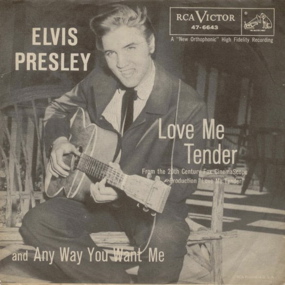 Variety, October 13, 1956:
Variety, October 13, 1956:
 Variety, October 13, 1956:
Variety, October 13, 1956:Elvis Presley: "Love Me Tender"-"Anyway You Want Me" (RCA Victor). Like his previous disks, this Elvis Presley platter is an automatic hit. But "Love Me Tender," the title song from the 20th-Fox pic in which Presley is making his film bow, is a change-of-pace material for this singer. Instead of the frantic, note-breaking style which has characterized Presley's other vocals, he makes an effort to sing in a legit ballad style. The result is not too striking, but the Presley fans will undoubtedly go for it. On the flip, Presley reverts back to his normal style, and this side could be the one to step out as the top side.
Presley led off Variety's "Best Bets" list again, this time topping new recordings by Cab Calloway, "Bill Haley & His Comets," and Caesar Giovannini. In labeling Presley's ballad delivery on "Love Me Tender" as "not too striking," Schoenfeld revealed his continuing inability to understand Elvis's allure. His prediction that "Anyway You Want Me" on the flip would be the hit side missed the mark by a long shot as "Love Me Tender" shot to the top of the charts.
In the September 5 article, Variety acknowledged that Elvis Presley was "the hottest disk name to turn up in this era." On track to sell 10 million records during his first year on the RCA Victor label, Presley's royalty payoff was estimated at $400,000 in 1956. Those 10 million records sold would also mean a gross income of $5 million for RCA. And sales would only get better during the following year.
Elvis Rock ’n’ Rolled in 1961 For the USS Arizona Memorial
Elvis Rock 'n' Rolled in 1961
For the USS Arizona Memorial
Alan Hanson
"This is the first time I've appeared live in nine years." That's what Elvis Presley told his opening night audience at the International Hotel in Las Vegas on July 31, 1969. Actually, it had been exactly 8 years, 4 months, and 6 days since he had last performed live on stage. During the interim, Elvis toiled in Hollywood, starring in an amazing total of 24 films. When Elvis walked off the stage in Honolulu the evening of March 25, 1961, he couldn't have imagined that it marked a turning point in his career. That it did so made that Hawaii concert a key event in his career.
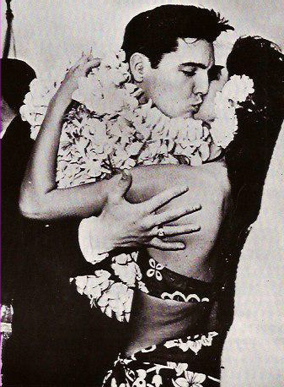 According to Ernst Jorgensen and Peter Guralnick in their book, Elvis – Day By Day, the genesis of the '61 concert in Hawaii occurred on December 4, 1960, when Colonel Parker read an editorial in the Los Angeles Examiner about the effort to raise funds for a memorial to the USS Arizona in Pearl Harbor. It occurred to Parker that Elvis could perform a benefit concert in Honolulu before filming of his next movie began there in March 1961. After getting the OK from Elvis, Parker began making plans. The Colonel held a press conference to publicly announce the coming concert on January 11, 1961, at the Hawaiian Village Hotel in Honolulu.
According to Ernst Jorgensen and Peter Guralnick in their book, Elvis – Day By Day, the genesis of the '61 concert in Hawaii occurred on December 4, 1960, when Colonel Parker read an editorial in the Los Angeles Examiner about the effort to raise funds for a memorial to the USS Arizona in Pearl Harbor. It occurred to Parker that Elvis could perform a benefit concert in Honolulu before filming of his next movie began there in March 1961. After getting the OK from Elvis, Parker began making plans. The Colonel held a press conference to publicly announce the coming concert on January 11, 1961, at the Hawaiian Village Hotel in Honolulu.The next day both of the city's newspapers, the Advertiser and the Star Bulletin reported on the press conference. Parker revealed that Elvis would appear in Honolulu on Sunday, March 26, at a benefit concert for the USS Arizona Memorial Fund. "Every penny of that taken in must go to the fund," Parker explained, "otherwise, we are not interested in doing the show. In fact, Elvis told me over the telephone last Tuesday night that he'll buy the first ticket for $100."
Tickets ranged from $100 to $3
Bloch Arena at Pearl Harbor would be the venue. Of the 4,000 seats available, 100 "ringside" seats would be sold for $100 each. The rest of the tickets, scaled at $10, $5, $3.50, and $3, would go on sale March 13. "Not a living soul will get a free ticket to this show," stated H. Tucker Gratz, chairman of the memorial fund commission. "And that includes the performers, and even Colonel Parker." Parker said he and Elvis would pay all other performers out of their own pockets, and all expenses would be donated.
"This is a little bit like a kid who has heard of Santa Claus and can't believe it," Gatz said. "Our sincere thanks to Colonel Parker. It's hard to believe this is real."
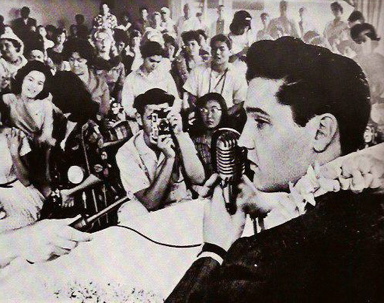 "It is," Parker confirmed. "You know, Elvis is 26 (last Sunday was his birthday) and that's about the average age of those boys entombed in the Arizona. I think it's appropriate that he should be doing this." Setting a fundraising goal for the show, Parker added, "There's no excuse for Elvis to leave this island without his raising $50,000."
"It is," Parker confirmed. "You know, Elvis is 26 (last Sunday was his birthday) and that's about the average age of those boys entombed in the Arizona. I think it's appropriate that he should be doing this." Setting a fundraising goal for the show, Parker added, "There's no excuse for Elvis to leave this island without his raising $50,000." Shortly after Colonel Parker returned to Los Angles, he announced a couple of changes in the benefit concert's schedule and seating arrangements. The show date was moved a day earlier to Saturday, March 25. Also, the "ringside" $100 ticket section was expanded from 100 to 300 seats.
On Monday, March 20, 1961, five days before the Pearl Harbor show, Elvis reported to Paramount studio in Hollywood to begin work on Blue Hawaii. On the same day, his single release of "Surrender" reached #1 on Billboard's Hot 100. It was Elvis's fourth straight #1 record in less than a year.
Long day for Elvis begins at LA airport
The morning of March 25, 1961, Elvis boarded a Pan American Airways jet in Los Angeles to start what he knew would be a long, tiring day for him. Even before the plane took off from LA, an estimated crowd of 3,000 began gathering at Honolulu International Airport to greet Elvis on his arrival. At 12:15 p.m. the plane carrying Presley touched down in Honolulu, and at 12:27 Elvis, wearing a black suit and a ruffled white shirt, appeared at the rear door.
"For 10 minutes the handsome lad with the baby blue eyes passed in review," reported a local newspaper, "just like they do in the Army—up and down before the crowd with the wire screen and a cordon of Honolulu and military police between him and the fans. Some of them looked as though they were ready to tear him limb for limb, and take home the pieces for souvenirs … Soon, Elvis was weighed down with leis and smeared with lipstick (lucky girls). Presley and his party didn't venture into the crowd. Looking pale, Elvis paused only twice in his march up and down outside the fence. Once he stopped to let a little girl give him a lei and he rewarded her with a sweet smile."
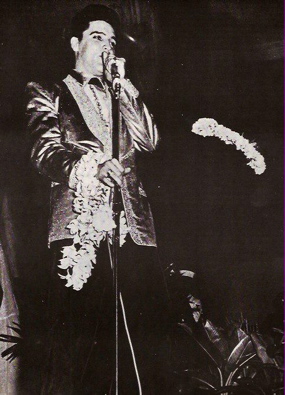 Then Elvis jumped into a waiting car and was escorted by police to the Hawaiian Village Hotel, where he would stay for three weeks while filming Blue Hawaii. At 3:45 p.m. Elvis entered the hotel's Carousel Room for a press conference. Local columnist Shideler Harpe reported that "Elvis sauntered in, looking sleepy-eyed and rumpled because he'd just finished a little nap, and before you could say 'Blue Hawaii,' a little girl hung a lei around his neck and wouldn't let go. Elvis looked a bit wild-eyed and Colonel Tom Parker finally disengaged him from the kid's clutch."
Then Elvis jumped into a waiting car and was escorted by police to the Hawaiian Village Hotel, where he would stay for three weeks while filming Blue Hawaii. At 3:45 p.m. Elvis entered the hotel's Carousel Room for a press conference. Local columnist Shideler Harpe reported that "Elvis sauntered in, looking sleepy-eyed and rumpled because he'd just finished a little nap, and before you could say 'Blue Hawaii,' a little girl hung a lei around his neck and wouldn't let go. Elvis looked a bit wild-eyed and Colonel Tom Parker finally disengaged him from the kid's clutch."Then Elvis answered questions from about 100 high school newspaper reporters and Honolulu newsmen and radio DJs before returning to his hotel room to rest up before the show that evening. Meanwhile, lines were already forming at the entrances to Bloch Arena. "At 6:30 p.m., two hours before show time, the crowds extended for blocks," according to a news report. "Traffic began jamming in the area about 7 p.m. as parking lots and later all available space on nearby lawns and streets filled to overflowing. The arena filled quickly when the gates were opened at 7:15 p.m."
Elvis wears gold lamé coat for the last time
The show began at 8:30 p.m., but Elvis didn't take the stage until after intermission. Among the opening acts were pianist Floyd Cramer, the Jordanaires, jazz saxophonist Boots Randolph, and comedienne Minnie Pearl. After intermission, Rear Admiral Robert L. Campbell introduced Elvis.
"When Elvis came on the teenagers screamed for 2 ½ minutes without let-up," according to an article in the Advertiser the next day. "Elvis was wearing his famous gold jacket with the silvery glints like sequins, dark blue trousers and a white shirt and a blue string tie. He wiggles as much as he ever did. The Army didn't make him a bit conservative."
During an hour on stage, Elvis sang 15 songs: "Heartbreak Hotel," "All Shook Up," "A Fool Such As I," "I Got a Woman," "Love Me," "Such a Night," "Reconsider Baby," "I Need Your Love Tonight," "That's All Right," "Don't Be Cruel," "One Night," "Are You Lonesome Tonight," "It's Now or Never," "Swing Down Sweet Chariot," and "Hound Dog."
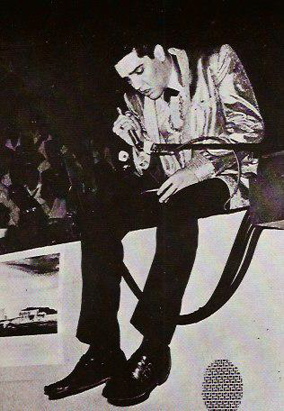 Advertiser Managing Editor Buck Buchwach labeled Presley "the hottest commercial attraction in the entertainment industry" in an editorial on March 27. "Elvis is a musical Messiah," he proclaimed. "For his fans, he has an animal magnetism that communicates itself more strongly than any entertainer we've ever seen or heard … he's much more handsome, much more appealing, much more likeable, and a much better entertainer in person … than on records, over TV, and in movies."
Advertiser Managing Editor Buck Buchwach labeled Presley "the hottest commercial attraction in the entertainment industry" in an editorial on March 27. "Elvis is a musical Messiah," he proclaimed. "For his fans, he has an animal magnetism that communicates itself more strongly than any entertainer we've ever seen or heard … he's much more handsome, much more appealing, much more likeable, and a much better entertainer in person … than on records, over TV, and in movies." Elvis does "Hound Dog" knee slide for the last time
Elvis concluded his performance by sliding six feet across the stage on his knees while singing "Hound Dog." The screaming and applause continued even after Elvis left the stage. Reporter Phil Mayer noted, "This acclaim saluted more than his performance. The applause also was for a man helping build a monument the best way he knows how."
Gross ticket sales were $52,000, surpassing the $50,000 goal Colonel Parker had originally set. An additional $5,000 check from Colonel Parker and Elvis, along with concessions revenue and additional donations collected at the arena, pushed the memorial commission's proceeds over $62,000. Although the amount was not enough to complete the memorial, it was enough to prepare the memorial for dedication. "I can assure you that on December 7 of this year there will be a memorial," stated fund chairman Gatz after all the receipts had been added up.
The USS Arizona Memorial was dedicated on May 30, 1962. Today the more than 1 million annual visitors can view a plaque (below) that recognizes Elvis Presley as one of the contributors to the memorial. Various Presley merchandise and artifacts from the 1961 benefit show are kept in the memorial archives and can be viewed by appointment.
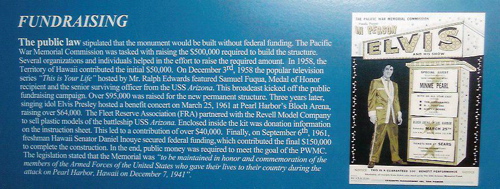
__
.
__,_._,___
Pollster Eugene Gilbert Brought Reason to Elvis Debate in the '50s
Pollster Eugene Gilbert Brought
Reason to Elvis Debate in the '50s
Alan Hanson
Back in fifties, everybody had an opinion about rock 'n' roll and Elvis Presley. Music and entertainment pundits generally condemned both the musical style and its leading proponent. At the other end of the spectrum, teenagers generally embraced rock 'n' roll and worshiped Elvis as its king. Of course, some critics accepted Elvis and some youths hated him. With so many emotional viewpoints being aired, it was hard to get a handle on Presley's actual influence on popular culture. At that time, people didn't have the scientific polling that we depend so much on these days to define societal trends.
There was one man, however, who tried to quantify the concerns of young people in the fifties. Eugene Gilbert, who billed himself as "President of the Gilbert Youth Research Company," wrote a weekly syndicated newspaper column under the banner, "What Young People Think." Each week he published and commented on a topic about which his company had surveyed teenagers and their parents across the country.
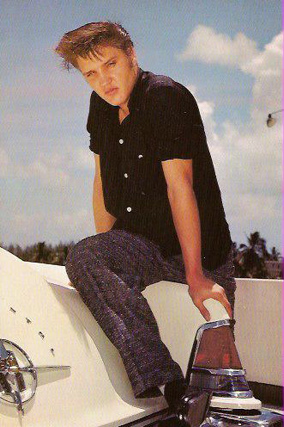 On at least four occasions during 1956 and 1957, Elvis Presley figured prominently in Gilbert's columns. The first came during the week of August 6, 1956. For that article, Gilbert stated, "Our organization interviewed over 3975 boys and girls and their parents in 41 cities across the nation to find out what young people themselves think about rock 'n' roll and its influence upon them."
On at least four occasions during 1956 and 1957, Elvis Presley figured prominently in Gilbert's columns. The first came during the week of August 6, 1956. For that article, Gilbert stated, "Our organization interviewed over 3975 boys and girls and their parents in 41 cities across the nation to find out what young people themselves think about rock 'n' roll and its influence upon them." California mother feared the "Elvis Presley cult"
Gilbert began his column with the following summary of his findings:"Teen-agers regard Rock 'n' Roll as a revved up version of the Charleston or Lindy-hop; and they see its most noted practitioner, Elvis Presley, as a latter-day disciple of Rudy Vallee or Frank Sinatra. Harried parents, for the most part, scorn this comparison with the music of their salad days."
Gilbert relied both on statistics and respondents' comments to make his points. He reported that 73 percent of the teen-agers who considered themselves rock 'n' rollers said the lyrics of a song were far less important than the "two-beat rhythm." He also noted that 83 percent of the parents "would prefer to see their children socially occupied in some other direction, but only 29 percent feel so strongly about it that they would like to see rock 'n' roll banned from their communities."
Concerning Elvis, Gilbert noted that many mothers and fathers looked "with distaste, not only on his performance, but also on its hypnotic after-effects." Gilbert cited one San Francisco mother's foreboding about what she called the "Elvis Presley cult."He also quoted two teenagers who defended Elvis. "They swooned over Sinatra and drooled over Rudy Vallee," said a New Jersey girl of parents. "At least Elvis isn't a milksop. We've much better taste—he's a real hunk of man!" A 16-year-old Texas girl added, "When Elvis sings, I'm on Cloud Nine. He makes me forget everything but the music—and him singing it."
Later column pronounced "Presley Fad on the Skids"
Eight months later, however, Gilbert's survey of teenagers across the nation found the number of Presley's defenders had dropped considerably. The week of March 17, 1957, Gilbert opened his "What Young People Think" column with the following statement: "Singer Elvis Presley's phenomenal popularity among the Nation's teen-agers seems to have taken a nosedive." He noted that in his nationwide survey the previous October, 35 percent of youngsters listed Elvis as their favorite male singer. But in his most recent poll, that number had dropped down to 21 percent. "That's still a hefty following—and also a remarkable decline," Gilbert concluded.
Furthermore, the new survey indicated that 35 percent of teenagers liked Presley less than they had the previous year. "He's nothing anymore," Gilbert quoted a 16-year-old girl. "Last year he was news. Today he's just another wiggler." Another high school girl added, "Last year I used to think Elvis was the sexiest male alive. But I can see now that he'll become just another commercial singer, like the rest."
Gilbert admitted that those were "extreme viewpoints," and that Presley's recent move, Love Me Tender, had apparently resulted in some young fans liking him even more. "Elvis was the very end in that movie. I bet someday he gets an Academy award," responded one girl. Another acknowledged, "I sat through 'Love Me Tender' three times in one afternoon. I was in a happy daze for a week afterward."
Gilbert offered several other results from his March survey concerning Elvis. First, at 21 percent Presley still topped the "Most Favorite Male Vocalist" category, although Pat Boone, with 13 percent of the vote, was moving up strongly and threatened to depose the King.
Elvis fans rebels who can't face adult world
Later in the summer of 1957, Gilbert engaged in what he called "motivational research" to determine "what sort of teen-ager really likes Elvis Presley—idolizes him from the top of his bushy brown hair to the soles of his blue suede shoes?" He started by questioning 100 random teenagers about their school activities, grades, and future plans. From their responses, Gilbert established a pattern for the average teenager. He then used that pattern to come up with a sketch of a typical Presley fan.
The result produced an unfavorable picture of Elvis fans. First, most were not joiners. Only 33% of Presley's most enthusiastic admirers were members of a club, society, or other school, church, or community group. Pat Boone and Frank Sinatra fans were joiners at a higher rate of 50%. Second, Elvis followers were low achievers in school. The average school grade for Presley fans was "C" compared to "B" or better for the Sinatra and Boone crowd. In fact, 20% of Elvis fans said they didn't care one way or the other about school grades. Finally, Presley enthusiasts seem unconcerned about the future. Many didn't bother to respond to the question asking about their future aspirations, and 30% admitted they had "never given it a thought."
In analyzing these findings, Gilbert's staff started with the sociological assumption that the typical teenager is faced with a dilemma: "More and more demands are being imposed upon him by the adult world, yet he still clings to his dependent, infantile existence of former years." Gilbert's researchers then came to the following conclusion.
"In this nether world between childhood and manhood, Elvis Presley emerges as a symbol of destruction. Presley is unacceptable to the adult world, and, to the unadjusted teen-ager, he seems to mock its cultural taboos. Through an alliance of the spirit with Presley, the teen-ager is able to act out his infantile desires of striving for power through the destruction of adult standards and symbols. He can satisfy his need to belong by uniting with other youngsters of similar aim."
"How long will Presley's popularity last?"
The March survey also asked teenagers how long they thought Presley's popularity would last. Thirty-nine percent of boys and 33 percent of girls predicted that the Elvis "fad" would fade away in less than a year. "Forty-two percent of the girls and 31 percent of the lads gave him from one to two years," Gilbert added, "and 8.5 and 17 percent, respectively, figured two to four years more, while the rest thought the side-burned rock 'n' roller wouldn't fade for another four years yet." A Duluth, Minnesota, girl explained, "We like him, but you can't expect a fad to go on forever."
Despite what Eugene Gilbert's poll indicated, the Presley "fad" was far from being on the skids. The week after Gilbert's March column appeared in newspapers, a gold lamé clad Elvis opened his 1957 spring concert tour in Chicago. Huge crowds came out to see him in most of the 18 cities he played that year. His April single release, "All Shook Up," shot up Billboard's "Hot 100" and stayed there for 30 weeks. Two more #1 hit records, "Teddy Bear" and "Jailhouse Rock," followed, both from highly successful Presley movies.
As a result, Presley's name again showed up in Gilbert's "What Young People Think" column early in October 1957. The survey question this time was, "Who would you like to be most like when you grow up?" President Eisenhower easily topped the boys' list with 31 percent of the vote. Elvis Presley, though, came in second with 14 percent. That was more than twice what Vice President Richard Nixon earned in third place. Others finishing well below Elvis were Babe Ruth, John D. Rockefeller, Mickey Mantle, and Albert Schweitzer.
Most of the boys who wanted to be like Elvis coveted his material success. "This Presley lives it up," one 16-year-old observed. "Cars, gals, money to burn. Any kid would like his share." A Texas teen zeroed in on the gals. "Girls! Girls! Girls! Elvis has them by the hundred. Man, wouldn't I dig that! You bet I would!"
The pollster helped temper the Presley controversy in the fifties
Eugene Gilbert never used the term "scientific" in reference to the polling he did for his "What Young People Think" columns in the fifties. No doubt his methods were primitive compared to those of modern pollsters. For his time, however, Gilbert's nationwide surveys at least brought some fairness to the emotional Presley controversy. His poll numbers lent some reasonableness to the debate, and he was always careful to make sure both sides had their say.
Of course, in Gilbert's March 1957 poll, those 39 percent of boys and 33 percent of girls who felt the Presley "craze" would end in less than a year were right. It wasn't, however, because Elvis's gyrating rock 'n' roll style lost its allure among young people. Rather, it was Uncle Sam who ended the Presley "fad" in March 1958. —
Elvis & Sinatra: More in Common Than You Might Think
Elvis & Sinatra: More in Common
Than You Might Think
Alan Hanson
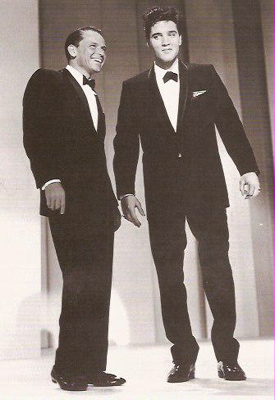 In the early years of Elvis's booming success, journalists asked both men to comment on the other. Interviewed on the set of Pal Joey in June 1957, Sinatra named Pat Boone as "the best of the new talent." Asked specifically about Elvis, Frank said it was too early to judge whether or not he was a "freak." He added, "They said I was a freak when I first hit, but I'm still around. Presley has no training at all. When he goes into something serious, a bigger kind of singing, we'll find out if he is a singer. He has a natural animalistic talent."
In the early years of Elvis's booming success, journalists asked both men to comment on the other. Interviewed on the set of Pal Joey in June 1957, Sinatra named Pat Boone as "the best of the new talent." Asked specifically about Elvis, Frank said it was too early to judge whether or not he was a "freak." He added, "They said I was a freak when I first hit, but I'm still around. Presley has no training at all. When he goes into something serious, a bigger kind of singing, we'll find out if he is a singer. He has a natural animalistic talent."Elvis, on the other hand, was very guarded when he spoke about Sinatra in the fifties. During nearly all of his press conferences preceding his 1957 concert appearances, Elvis was asked to name his favorite singers. Among them he listed crooners like Dean Martin and Nat King Cole, but not Sinatra. At an April press conference in Canada, he was asked about Sinatra in particular. "I can take him or leave him," was Elvis's noncommittal response.
In Los Angeles on October 28, 1957, however, Elvis spoke pointedly about some comments Sinatra had recently made about rock 'n' roll in a French magazine. Frank called rock 'n' roll "the most brutal, ugly, degenerate, vicious form of expression it has been my displeasure to hear" and declared that "it is sung, played and written for the most part by cretinous goons."
Elvis accused Sinatra of taking unfair potshots at rock 'n' roll
Although Sinatra didn't mention Elvis directly, as the reigning "King of Rock 'n' roll," Presley was duty-bound to respond. "I admire the man," Elvis said, choosing his words carefully. "He has a right to his own opinions. He is a great success and a fine actor, but I don't think he should have said it. I don't think anyone has the right to take potshots at something that is definitely a trend. It's an American development, just like crooning was a few years back."
Of course, any animosity between the two entertainers (if any really existed in the first place) was forgotten when Elvis made his first public appearance after leaving the army in 1960 on Frank's network TV special. The two men seemed very much at ease performing together on stage that night. Afterwards they went their separate ways and only occasionally had personal contact with each other over the years.
Will Friedwald, the author of seven books on music and popular culture, discussed the Sinatra-Presley connection in an article published in the February/March 2005 issue of American Heritage magazine. Friedwald contends that one difference in the careers of Sinatra and Presley is that Elvis's catalog of recorded songs looks meager compared to Sinatra's. Of course, Frank's longer lifespan meant he recorded more songs than Elvis, but Friedwald was referring more to the disparity in the quality of songs the two men recorded. He put the blame on Elvis's publishing arrangement.
When Elvis first signed with RCA Victor in 1956, Colonel Parker had the firm of Hill and Range create a song publishing company for Presley. To maximize his client's income, Parker insisted that Elvis record only songs for which Hill and Range owned the publishing rights. And throughout his career, Elvis rarely ventured outside H&R for recording material. Friedwald believes this restriction kept Elvis from recording many songs that would have been perfect for him.
Elvis wasted too much time on mediocre songs
Sinatra, on the other hand, did not limit himself. "Sinatra had also owned publishing houses," Friedwald explained, "but unlike Presley, that hadn't stopped Sinatra from consistently recording the best songs he could find. Unfortunately, Presley was importuned to waste too much energy making mediocre songs—which he usually owned a piece of—sound better than they were."
One related similarity between the two singers was that neither one claimed to be a serious songwriter. "The strength of both," Friedwald contended, "was that they could interpret a song written by someone else, and make it into something considerably more magical, and even personal, than the guy who wrote it. Eddy Arnold was a first-rate country singer, but even he can't touch Presley's reading of his own 'You Don't Know Me.'"
Friedwald mentioned a conversation Frank Sinatra once had with his daughter, Nancy, a good friend of Elvis's and his costar in the 1968 movie Speedway. Her father was critical of Elvis because he felt he'd never taken the opportunity through the years to grow as an artist. Nancy argued that the people around Elvis never allowed him to explore new creative avenues.
"Sinatra rejected that excuse," said Friedwald. "From his perspective, we can't blame him. The old man would never let anybody stand in his way in terms of choosing a song or finessing an arrangement or a recording mix to perfection. And this conversation represents a rare occasion in which Frank Sinatra discussed Presley as even potentially an equal or kindred spirit. But he was. They both were only children who demanded the company of an entourage around them when they grew up; they both were extremely devoted to their mothers; they were among the relatively few singers who attained superstardom in Hollywood; and they both had a lot of comebacks."
Like Sinatra, Elvis may have been better off as a "gangster"
It wasn't as if Elvis didn't care about how RCA mixed his recordings once he left the studio. Joe Esposito has described how Elvis worked with the studio engineers to mix his recordings, and then had an acetate pressed so he could compare it to the version that RCA released. He was often upset when the company altered the sound he created, but he rarely did anything about it. In such cases, Sinatra did do something about it.
Of Elvis, Friedwald noted, "Like Sinatra before him, he wanted to work only with the best actors and musicians and with superior songs. The difference between him and Sinatra was one of temperament. Sinatra, like Ray Charles, constantly made his own opportunities, and heaven help you if you got in his way. Perhaps Presley was too nice and civil a guy. Perhaps to stick to your standards in Hollywood, you had to be something of a gangster."
Certainly both Elvis Presley and Frank Sinatra have achieved iconic status decades after their heydays. Both continue to make new fans who were not even born when their heroes died. Their styles may have differed, but their names will forever appear together at the top of the list of "The 20th Century's Greatest Entertainers."
Suscribirse a:
Entradas (Atom)



